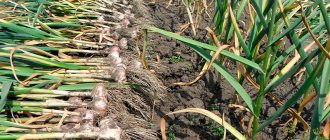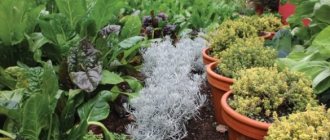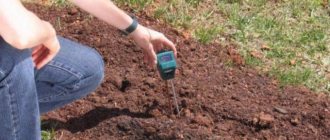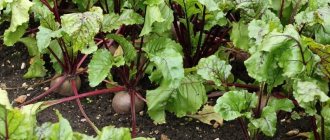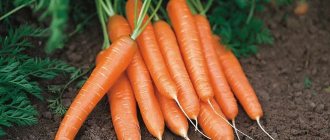What soil and growing conditions do tomatoes need?
Lighting
Tomatoes are a heat-loving and light-loving vegetable crop.
During the period of fruit ripening, the plant requires bright, intense lighting, otherwise the fruits will be less tasty.
- The seeds of this vegetable plant can germinate at a temperature of at least +14°C, but at higher temperatures (within 20-22°C) sprouts appear faster.
- And the growth of adult plants begins to slow down at temperatures below +12°C; shoots stop growing completely when the thermometer drops below +9°C.
If plants do not have enough lighting, they begin to stretch out and weaken. As a result, flowering and fruiting of these plants will be delayed. Lack of lighting is especially dangerous when growing seedlings at home.
Air humidity
The next requirement is optimal air and soil humidity.
The level of air humidity should not exceed 60%, and soil - 70-75%.
Increased air or soil humidity can lead to the development of various fungal diseases, root rot, and blackleg. Some of these diseases cannot be cured, so the plants have to be destroyed.
Fertilizer
Tomatoes also require nutrients; plants can only obtain them from the soil. Therefore, the beds in which tomatoes will grow must be pre-fertilized.
- In the fall, when digging, organic matter (compost, humus, manure) is added to the soil at the rate of 10 kg per square.
- In the spring, when digging again, complex mineral fertilizers are added to the soil, and then beds are formed in which tomato seedlings will be planted.
During the growth of seedlings, normal development of the root system requires a large amount of phosphorus, which is part of the nutrient substrate.
And then the seedlings are fed with a solution of complex mineral fertilizers twice before they are transplanted into open ground.
After transplanting the seedlings into the beds during the flowering period and the formation of ovaries, the growing bushes require potassium and phosphorus.
These minerals contribute to:
- active flowering;
- the appearance of a large number of ovaries;
- strengthening immunity.
As a result, tomato bushes develop faster, a larger number of ovaries are formed, and the plants themselves practically do not get sick, which also has a positive effect on the yield of this vegetable crop.
Effect of nitrogen on tomatoes:
- This macronutrient has a beneficial effect on any cultivated plants.
- Activates the growth of vegetative mass and root system.
But it must be introduced into the soil with caution. An excess of nitrogen leads to increased development of green mass to the detriment of flowering and fruiting, and a deficiency leads to slower growth, lightening of the foliage, and the fruits will be too small.
Priming
The best types of soil for this vegetable crop are sandy and loamy with a neutral or slightly acidic reaction.
Under such conditions, the first fruits on tomato bushes can ripen 1-1.5 months after the flowers appear.
Growing in greenhouses
Most often, summer residents grow tomatoes in greenhouses. If you have several greenhouses in your garden, the best option is to alternate planting tomatoes and cucumbers. After the end of each season, the soil in the greenhouse should be thoroughly disinfected to prevent the spread of fungus.
This approach to cultivation will reduce the likelihood of diseases occurring in planted crops, since they belong to different families.
Before planting cucumbers where tomatoes grow, the soil in the greenhouse should be thoroughly disinfected and fertilized. After a year, tomatoes can be planted again in place of the cucumbers.
Is it possible to plant tomatoes in the same place for years if only one greenhouse is built in the garden?
If a summer resident does not have the opportunity to change the location of planting tomatoes, then to grow them in a greenhouse for several years, in the winter - after harvesting, it is necessary to plant mustard. At the same time, mustard should be grown to fertilize the soil. In addition to its fertilizing function, mustard perfectly disinfects the soil, equalizes its acid-base balance and normalizes its composition.
In the fall, it is necessary to collect and burn the remains of tomato bushes. In the spring, the mustard is removed, and after that the tomatoes can be planted in their original place.
Tomato bushes should not be planted several times in a row in a greenhouse. Between plantings, crops must be planted that will help the soil normalize the acid-base balance and make it more fertile. This is due to the fact that tomatoes deplete the soil, and in greenhouse structures this process is activated, since the soil in them is isolated from the influence of the external environment.
Also, such cultivation provokes the accumulation of harmful bacteria and spores, which increases the risk of re-infection of tomato bushes with phytospores or other characteristic pathologies even after cultivating the land.
Is it possible to plant tomatoes after tomatoes?
According to the rules of crop rotation, tomatoes can be planted in one place only for one season, and then take a break for 3-4 seasons.
If the garden or greenhouse is small, and you have to grow this crop in one place constantly, then after harvesting and destroying the tops, you need to disinfect the soil.
Or remove the top layer of soil by 5 cm. If the tomatoes are sick, then remove the soil to a thickness of up to 10 cm, then spill the soil with a solution of copper sulfate or Bordeaux mixture. Instead of the removed soil, a nutrient substrate is poured, consisting of a mixture of turf (or leaf soil), sand and humus in a 1:1:1 ratio.
Important! When tomatoes are constantly grown in one place, the soil in this area becomes too acidic, so during autumn digging, lime or chalk is added to the soil.
What to plant before tomatoes
Tomatoes most need potassium, phosphorus and nitrogen. Accordingly, the soil for growing them must be rich in these microelements. Poor predecessors for tomatoes are potatoes, peppers, peas, physalis, and eggplant. Also, you cannot plant tomatoes for more than 2-3 years in a row in the same bed.
As for good predecessors for tomatoes, they are:
- any cabbage (white cabbage, cauliflower, etc.);
- pumpkin crops (pumpkin, zucchini, squash, cucumbers, melon);
- turnip;
- carrots and beets;
- green onions and green manure herbs.
It is better to change the location of planting tomatoes once every two years.
In the beds where tomatoes have been grown for 4-5 years in a row, cabbage and pumpkin crops are planted, after which the tomatoes produce good yields. If the place where tomatoes are planted changes at least once every 2 years, then you can choose any of the above crops.
What to plant after tomatoes next year
Tomato is the best predecessor for the following vegetable crops:
- radish;
- beets;
- carrots;
- cabbage;
- Luke;
- garlic;
- beans;
- peas;
- beans;
- soy;
- dill;
- parsley;
- salad;
- celery;
- cucumbers;
- squash;
- zucchini.
In the open ground
Since tomatoes, during the process of growth and fruiting, take almost all the nitrogen from the soil, it is therefore better to plant legumes and those types of greens after them, which, along with legumes, during the growth process enrich the soil with easily digestible nitrogen and at the same time enrich it with organic substances.
Important! During the growth process, almost all root vegetables absorb nutrients from deeper layers of soil than tomatoes, so they can also be grown after tomatoes.
Onions and garlic, as they grow, disinfect the soil, destroying pathogenic microorganisms, and their yield will be high.
Any of the representatives of pumpkin crops can be planted after tomatoes, you just need to apply restorative fertilizers.
In the greenhouse
The following vegetables and root crops can be planted indoors:
- all varieties of cabbage;
- radish;
- cucumbers;
- zucchini;
- greenery;
- spices.
All varieties of cabbage are indifferent to the lack of nitrogen in the soil and are not susceptible to the diseases that affect vegetables from the nightshade family. And before planting vegetable plants from the pumpkin family, it is necessary to add organic fertilizers to the soil.
Greens and all types of herbs grow well after tomatoes, and also help disinfect the soil.
Also, to disinfect the soil after tomatoes, you can plant any green manure.
Is it possible to plant peppers, onions, garlic, beets, carrots?
After tomatoes, you should not plant other vegetables from the nightshade family, as they can be affected by the same diseases, and they are also damaged by the same insect pests, so it is strictly forbidden to plant bell peppers after tomatoes.
Onions and garlic after tomatoes destroy pathogenic microorganisms that could remain in the soil and produce good harvests. And carrots, as a root crop, take nutrients from the soil deeper than a tomato, and therefore also produce a good harvest.
Basic information about the culture
Tomatoes belong to the nightshade family; in South America, where they come from, wild varieties of this plant are common. The vegetable came to Europe in the mid-16th century, to Russia 200 years later and was used as an exotic plant, and was considered extremely poisonous. In European countries, tomatoes were also considered poisonous, and only thanks to the work of the Russian botanist Andrei Timofeevich Bolotov, who was able to develop methods for ripening fruits, this species began to be used for cultivation for food purposes.
Tomato fruits
The fruits, depending on the variety, have different sizes, shapes and tastes. Tomatoes have gained a strong position in the cuisine of different nations; it is simply impossible to imagine some national cuisines without them, for example, Italian. They are consumed raw in salads, added to soups and stews, stewed, pickled, juices and sauces are made.
The popularity of this species is due not only to its unique taste, they contain many essential vitamins, microelements and have low calorie content, which is in demand nowadays. Systematic consumption of vegetables helps prevent hypertension; the high content of coarse fibers promotes the functioning of the gastrointestinal tract and cleanses the body of toxins, and reduces the likelihood of developing cancer.
Due to their excellent taste, variety of uses for food purposes and the presence of vitamins and microelements, tomatoes are grown in our country from the southern regions to the northern latitudes. However, not everyone and not always succeed in getting good harvests; this crop requires attention, knowledge of the peculiarities of agricultural technology and hard work.
Planting tomatoes
The popularity of tomatoes in our country is so great that they are grown in all regions of the country where they cannot be grown in open ground; they are grown in greenhouses, greenhouses, and indoor conditions.
Planting tomatoes
Considering the region of origin of vegetables, it is clear that they are a heat-loving crop.
Important! For normal development, they require temperatures of 20-25 degrees; at temperatures below 15 degrees, fruits do not set; at temperatures of −1, the plant dies.
The plot of land for planting is chosen to be well-cultivated, with loose, fertilized soil. Before planting tomatoes, it is possible to place any crops on the site, except those belonging to the nightshade family, such as potatoes. Also, do not forget that not every crop can be planted after tomatoes if you are counting on getting a harvest.
Tomatoes are planted when the soil warms up to 10 degrees. Choose an open sunny area for planting; tomatoes are very responsive to sunlight. You can plant tomatoes in any soil, but it is preferable to choose loose, fertile, well-warmed soil.
The land for planting is prepared in the fall, cleared of the remains of dry plants, dug up, fertilizers are added, humus in the amount of 4 kg per square meter and superphosphate, 70 g. Tomatoes are demanding and responsive to feeding. Nitrogen fertilizers stimulate the growth of green mass; the development and ripening of fruits is promoted by phosphorus and potassium fertilizers. You should not overuse fertilizers.
Preparing the soil in autumn
Vegetable crop rotation table
| Can be planted | Neutral | Can't plant | |
| Potato | Legumes, pumpkins, cabbage | Any root vegetables, onions, garlic | Vegetables from the nightshade family |
| Tomatoes | Pumpkin, legumes, onions, garlic, carrots, all types of cabbage, greens | Beetroot | Potatoes, peppers, eggplants |
| Eggplant, pepper | Cucumbers, zucchini, cabbage, onions, garlic, melons, beans, carrots, greens | Beetroot | Potatoes, tomatoes, pumpkin |
| Onion garlic | Potatoes, legumes, pumpkin crops, all types of cabbage | Beetroot, tomatoes | Pepper, onion, garlic, physalis, greens, carrots |
| Pumpkin crops | Legumes, potatoes, all types of cabbage, tomatoes, onions, corn | Beetroot, greens | Pumpkin crops |
| Legumes | Pumpkins, strawberries, potatoes, all types of cabbage, onions | Beets, tomatoes, greens, carrots, vegetables from the nightshade family | Corn, legumes |
| Carrot | Onions, pumpkins, all types of cabbage, potatoes, greens | Tomatoes, onions, garlic, peppers, eggplants | Carrots, beets |
| Beet | Potatoes, pumpkins, greens | Legumes, tomatoes, onions, garlic, peppers, eggplants, corn | All types of cabbage |
| Cabbage | Onions, garlic, legumes, potatoes, cucumbers, zucchini, pumpkins | Tomatoes, carrots, peppers, eggplants, corn, greens | Cabbage, radishes |
| Greenery | Pumpkins, onions, garlic, legumes | Tomatoes, eggplants, peppers, beets, potatoes, corn | Cabbage, carrots |
What to plant after late blight-stricken plants to improve soil health?
Onion garlic. Bulbs are rich in natural phytoncides, which disinfect and heal the earth. After the tomato planting season, it is enough to give the soil a rest once by planting onions or garlic, and by next year you can plant tomatoes again.- Green manure (mustard, cereals, phacelia). Mustard and phacelia are natural disinfectants. Cereals renew and improve the soil.
These plants restore the microflora after diseased tomatoes and create favorable conditions for the growth of subsequent plants.
What crops will do best in the garden?
To get a high yield after tomatoes, it is better to plant:
- different types of cabbage;
- legumes;
- cucumbers;
- roots.
To improve soil health, it is better to plant after tomatoes:
- onion;
- garlic;
- mustard;
- phacelia.
What absolutely cannot be cultivated?
- Nightshades (potatoes, peppers, eggplants, physalis). Plants of the same family as tomatoes have similar nutritional needs, take the same microelements from the soil, and are affected by the same diseases. All this negatively affects the harvest.
- Strawberries, wild strawberries. Strawberries are sensitive to late blight, which affects tomatoes. Tomatoes strongly acidify the soil. In such an environment, strawberries will not be able to fully grow and bear fruit.
- Melons (watermelons, melons, pumpkins). The roots of tomatoes and melons are located at approximately the same depth and deplete the same layer of soil. Therefore, melons will grow and develop poorly after tomatoes and will produce a weak harvest.
Not all plants can be planted after tomatoes. Some crops develop well in the place where tomatoes grew. It is not recommended to plant certain plants after tomatoes. In cases where it is not possible to change the planting site, a drop in yield can be avoided if you apply fertilizers correctly and treat the soil and plants in a timely manner to remove pathogens. Knowing and applying the principles of crop rotation in the garden, you can always get a good result.
If you find an error, please select a piece of text and press Ctrl+Enter.
Then plant tomatoes
The best predecessors for tomatoes are the following vegetable crops:
- legumes;
- bulbous;
- greenery;
- carrot;
- radish;
- turnip;
- all types of cabbage;
- beet;
- pumpkin crops (for which organic fertilizers were applied);
- winter wheat;
- mustard;
- alfalfa;
- soybeans
In the open ground
If possible, in garden beds you should adhere to the basic rules of crop rotation.
Tomatoes are usually planted after:
- green manure;
- all vegetables from the cruciferous family;
- pumpkin and legume crops;
- any root vegetables;
- bulbous;
- greenery
In the greenhouse
Tomatoes can be planted indoors after the following vegetable crops:
- cucumbers;
- zucchini;
- all types of cabbage;
- radish;
- green manure;
- green crops;
- spicy herbs.
Tomatoes can be planted in the same place if the soil is disinfected during the break between plantings.
Is it possible to plant tomatoes after peppers, onions, garlic, potatoes, eggplants?
You cannot plant tomatoes after bell peppers, potatoes and eggplants, since all these vegetables belong to the nightshade family and can be affected by certain types of diseases, as well as insect pests.
And onions and garlic are the best precursors for tomatoes, as they help destroy pathogenic microorganisms and pests in the soil.
Features of alternating crops in the garden
The crop rotation developed by agronomists establishes a certain order for planting different crops.
When alternating plants, the state in which the soil remains after them is taken into account. How much and what nutrients they take out during the full cycle of their development, the toxicity of root exudates for subsequent crops.
Open ground
The best option when growing tomatoes and other vegetables in open ground is to use a three-year crop rotation.
Approximate rotation of crops in the garden depending on soil requirements:
- first year (demanding crops: all types of cabbage, cucumber, zucchini, celery);
- the second year (crops with an average level of nutrient requirements: nightshade, pumpkin, all types of lettuce, onions, corn), if the soil is severely depleted, then legumes are planted in the second year;
- third year (less demanding crops: all root vegetables, root parsley).
When planning crop rotation, the susceptibility of crops to the same diseases and pests must be taken into account.
In the greenhouse
It is much more difficult to organize crop rotation in greenhouses, which are almost always designed for tomatoes and cucumbers.
But still there are ways:
- 1 way. The greenhouse is divided into beds and the crops are swapped every year.
- Method 2. Holes are made in the garden bed and filled with soil mixture. After harvesting, the old substrate is selected and distributed throughout the site. The next year they are covered with a new substrate. It turns out that the soil under the tomatoes is changing, but with less labor.
- 3 way. Complete replacement of soil. To do this, dig a trench, lay organic matter on it and fill it with soil mixture. In the fall, the contents of the trench are removed and distributed on the site, and in the spring a new bed is made.
- 4 way. The soil is cleared of root exudates by green manure.
To avoid the accumulation of infection, the greenhouse and soil are disinfected annually.
Are cucumbers planted after tomatoes?
Any varieties of cucumbers can be planted after tomatoes, since this vegetable crop is not susceptible to late blight and is not demanding on soil quality. But before planting cucumbers in the beds, any organic fertilizers (compost, humus, rotted manure) should be added to the soil.
Can you plant cucumbers in the greenhouse after tomatoes?
In closed ground, cucumbers are planted after tomatoes only after adding a complex of mineral fertilizers and organic matter to the soil.
Not recommended crops
The following crops should not be grown in the place where the tomatoes were planted:
- other or similar varieties of tomatoes;
- potato;
- tobacco;
- physalis;
- strawberries;
- strawberries;
- eggplants.
This recommendation is due to the fact that tomatoes with the listed crops are affected by similar diseases and pests. Therefore, even after disinfection of the soil, signs of pathologies that previously affected planted tomatoes may appear on newly grown plants.
In order to avoid this, the listed crops should be planted away from the growing areas and the former growing area of tomatoes.
There is another argument against planting these crops on the former site of tomatoes. The fact is that tomatoes make the soil more acidic, and in such an environment the listed plants cannot fully grow, develop, and most importantly, bear fruit. Because of this, crops planted in the wrong place either die or produce a poor harvest.
See also
A selection of the best tomato varieties for the northwestern regionRead
What can be planted after tomatoes from melons? The answer to this question is clear: nothing. This is due to the fact that watermelons, melons or pumpkins planted in a former tomato area will bear fruit poorly, and the summer resident will receive a very modest harvest.
Many summer residents plant bell peppers next to tomatoes. It is not recommended to carry out such planting in a bed where tomatoes were previously grown for only one reason: the yield of bell peppers may be reduced significantly. If such a prospect does not frighten the gardener, he can plant this plant crop in place of tomatoes without fear of the bush being damaged by diseases or pests.
What not to plant after tomatoes
Tomatoes are bad predecessors for the following vegetable and garden crops:
- potatoes;
- physalis;
- all varieties of pepper;
- tobacco;
- eggplant;
- strawberries;
- strawberries
All of these crops are susceptible to the same diseases as tomatoes, and they can also be damaged by the same insect pests. therefore, all of the above plants may suffer from:
- late blight;
- rot;
- wireworm;
- Colorado potato beetle.
And even complete disinfection of the soil does not provide a 100% guarantee of the destruction of pathogenic microorganisms and pest larvae. Therefore, in the future, plants may be affected by these diseases.
After what crops can tomatoes not be planted?
Tomatoes are not planted after plants of the same family. They are susceptible to the same diseases and pests, and have similar root secretions that are toxic to followers. Over the course of a season, a certain supply of pathogens accumulates on the site and the permissible threshold of pests increases.
These are all nightshade crops:
- potato;
- eggplant;
- vegetable pepper;
- tobacco;
- physalis.
You cannot plant tomatoes in close proximity to potatoes. This leads to the rapid spread of late blight and damage to tomatoes by characteristic potato pests - wireworms and nematodes.
You should not place tomatoes after strawberries, even though they are not biologically related. The place for garden strawberries is changed every 3-4 years. By that time, the soil is greatly depleted, it contains many small roots and root secretions.
In addition, the crop has a common disease with tomatoes - late blight. For the same reason, it is advisable not to place them in adjacent beds. The area after the strawberries is sown with legumes or green manure crops; tomatoes are planted only the next year.
The best neighbors, what is better to plant next to tomatoes?
The best neighbors for tomatoes will be the following cultivated plants:
- corn;
- carrot;
- horseradish;
- radish;
- legumes;
- salad;
- onion;
- garlic;
- beet;
- garlic;
- spinach;
- cabbage;
- celery;
- radish;
- asparagus;
- parsley;
- basil;
- nasturtium;
- marigold;
- tansy;
- tagetis;
- coriander;
- calendula.
Marigolds, tagetis, tansy, nasturtium, coriander and marigolds repel most “harmful” bugs from tomatoes with their aroma.
Legumes and corn plantings save tomato bushes from strong wind gusts.
Basil planted nearby gives ripe tomatoes a unique aroma.
Onions and garlic planted next to tomatoes, which produce phytoncides, protect this crop from late blight. Onions repel aphids and flea beetles, and garlic protects against spider mites.
Tomatoes have a positive effect on the development of onions, garlic, legumes, all varieties of cabbage, prevent the appearance of scab on apple and pear trees, and can repel the codling moth.
Is it possible to plant tomatoes after tomatoes?
If you plant tomatoes every year, the acidity of the soil increases, the nitrogen content decreases, and phytotoxins accumulate. This harms not only future seedlings and the possibility of being affected by diseases, but also reduces yield by up to 30%.
You can plant tomatoes again next year, but only if you remove the top layer of soil up to 30 cm and add sand, peat, rotted organic matter to it, add dolomite flour, ash to reduce acidity and, to improve the quality of the fertile layer, mineral fertilizers with a high nitrogen content, as well as other elements:
- phosphorus,
- potassium,
- manganese;
- magnesium,
- iodine
But, it is better to correctly develop a crop rotation scheme that will help regularly grow healthy bushes rich in nutrients and get a high yield, and prevent soil fatigue.
Tomatoes are a fastidious crop, so you need to choose a new place for them every year. If growing occurs indoors, then properly prepare the soil and make it fertile and light.
Can I plant peppers, onions, garlic, beets, carrots?
It is not advisable to plant peppers in place of tomatoes, since they are related plants and carriers of common pests and diseases.
Beets, carrots, like all other root vegetables that grow after tomatoes, give an excellent harvest.
Onions and garlic bear fruit well in this place and have a beneficial effect on the soil.
Crop rotation table
What prevents joint cultivation?
Based on the above care requirements, it is worth considering growing cucumbers and tomatoes in the same greenhouse.
Reasons to avoid this approach:
- Cucumbers are moisture-loving plants, which cannot be said about tomatoes. Due to dampness, the latter are more likely to develop fungal diseases, they are less pollinated due to wet pollen and, as a result, bear less fruit.
- Tomatoes tolerate drought and high temperatures well. For cucumbers, such conditions are disastrous: they need moisture and coolness.
- Another reason is the need to ventilate the greenhouse for tomatoes. Cucumbers do not tolerate constant drafts well, because of this their vines develop worse and, accordingly, the yield is reduced.
- Tomatoes prefer potassium and phosphorus fertilizers and suffer from excess nitrogen. Because of this element, the bushes grow powerful, but the fruits do not have time to fill. Cucumbers, on the contrary, are lovers of the nitrogen component in fertilizers.
- Tomatoes will almost inevitably suffer from fungus due to high humidity. At the same time, they have a number of common ailments with greenies (anthracosis and mosaic). Accordingly, having originated in one crop, the disease will spread to another - there is a high risk of losing both crops.
- Crops also have common pests: mites, thrips, aphids, and whiteflies.
To enjoy both vegetables without restrictions, it is better to build a second greenhouse or even grow one of the crops without a greenhouse. Both the quantity and quality of the plant harvest will be better in these cases.
When to plant seedlings of tomatoes, peppers and cucumbers in a greenhouse
Most summer residents prefer to grow tomatoes, peppers and cucumbers in a greenhouse. The fact is that these crops are quite heat-loving, and this method allows you to harvest a much larger harvest than when growing them in open ground
When planting seedlings in a greenhouse, factors such as weather conditions and soil warming, the age of the plants and their general condition are important.
When to plant seedlings of peppers and tomatoes in a greenhouse
Tomato and pepper seedlings should be planted in a greenhouse at the end of April-beginning of May, but this applies to Central Russia, which includes Moscow and the Moscow region, in the Urals and Siberia the optimal time for planting is the end of May-beginning of June, in St. Petersburg - the end of May . There is no exact date for transplantation, as it depends solely on weather conditions. If the threat of frost has passed, the soil temperature is above +10 degrees, and the seedlings reach a height of 25-30 centimeters, each plant has more than eight well-developed leaves and at least two inflorescences, then the time for planting has come.
How to plant tomato seedlings in closed ground
You can choose any scheme for planting seedlings in a greenhouse, but you need to take into account that for plants to develop well, they need sufficient lighting and a lot of air, so you should not thicken the plantings. In the greenhouse, make small beds 30 centimeters high, dig holes 20 cm deep in each bed at a distance of 40 cm. Water the holes with a warm, weak solution of potassium permanganate at the rate of one liter per hole (this will protect the plants during the adaptation period from contracting diseases such as root rot, black leg, late blight, etc.). Two or three days before planting, tear off all yellow and cotyledon leaves from the seedlings, being careful not to injure the stems. Start planting in the afternoon after watering the tomatoes. Carefully remove the seedlings from the pots without destroying the earthen ball, immerse them in the holes, sprinkle with earth and tamp lightly. Water each tomato at the root with warm water (two liras per plant). Remember, if the plants have not outgrown, then you need to transplant them into the greenhouse so that the seedlings stand strictly vertically, but overgrown plants require a special approach.
How to plant overgrown tomato seedlings in a greenhouse
If the seedlings are from 50 to 70 centimeters in height, then in this case it is better to do this: dig holes 30 centimeters deep, place the plants in them and lightly sprinkle them, that is, do not completely bury the holes. After a couple of weeks, when the plants have taken root, cover the holes completely with soil. If the seedlings are about a meter high or a little lower, then in this case the seedlings need to be planted so that only the 30-centimeter tops peek out from the ground. A couple of days before transplanting, remove diseased and yellow leaves from tomatoes. In the greenhouse, make holes at an angle of 45 degrees, and from them make shallow grooves equal to the bare part of the seedling stems. Transplant the seedlings into the holes, bend their stems and bury them in the grooves. Using wire, make supports for the tops of the tomatoes, install them and secure the plants. Remember, during the entire growing period, tomatoes planted in this way must not be loosened or hilled. If the stems are exposed when watering, mulch these places with a small layer of peat.
Soil fatigue
Growing the same plants in one place usually leads to a reduction in yield and a deterioration in its quality. It happens:
- Due to soil depletion, since each crop consumes the microelements it needs from the soil, even the introduction of additional mineral fertilizers is not always able to correct the situation.
- Due to the fact that toxins released by plants accumulate in the soil and negatively affect the growth of some subsequent crops.
- Due to pathogenic bacteria and pests that accumulate in the soil, characteristic of a certain type of plant. The most striking example is late blight, the pathogens of which persist in the soil for up to six years and infect initially healthy planting material.
To avoid soil depletion, it is necessary to take into account such features of the plants being grown as the type of their root system, belonging to a certain family, which are necessary for the full development of the substance.
Basic concepts and principles
If different crops have approximately the same mineral composition (or even one mineral), then, naturally, each of the crops will deplete the soil of precisely this mineral. And the subsequent culture will feel very uncomfortable.
about cucumbers, I simply say that it is good to plant beans or legumes, and accordingly, after beans and legumes, cucumbers grow well. You definitely shouldn’t plant tomatoes after eggplants.
Therefore, it is advisable to sow green manure legumes after harvesting tomatoes. In the spring, mow the grass for green fertilizer, make holes in the beds and plant the next batch of tomatoes.
- Taking these two rules into account, we will create a priority list for tomatoes.
- Tomatoes can also be planted after beets. Before planting tomatoes, you need to prepare the soil well, that is, it needs to be fertilized. Peat and humus are suitable as soil amendments.
- Dividing plants according to their level of nutrient needs:
Beginning summer residents do not always know what to plant after beets or other vegetable crops to obtain a good harvest every year. How long can it take to grow other vegetables and which ones exactly after the beets have been harvested? Not everyone is familiar with the intricacies of organizing plantings on a plot, so amateur gardeners more than once encounter such problems as lack of harvest or low-quality fruits.
Caring for joint crops
Cucumber care
Cucumbers are moisture-loving plants that require abundant and frequent irrigation with warm water. Settled water is ideal for irrigation. It is recommended to use a foliar spray. The optimal humidity in a greenhouse is 85%. If these rules are followed, the yield of cucumbers will be high.
For uniform plant growth and the appearance of ovaries, the temperature should be at least 22 and not exceed 28 degrees. Cucumbers do not tolerate ventilation and natural drafts. Do not forget about regular feeding of seedlings.
Until the cucumber fruits appear, water the seedlings frequently, but not abundantly. As a result, female flowers will form, which will allow you to harvest a good harvest. After the fruits appear, it is necessary to increase watering.
Tomato care
Tomatoes need to be grown in polycarbonate structures.
- The size of a proper bed should be 90 cm wide and 40 cm high. It is ideal to leave a passage between seedlings of approximately 60 cm. A passage between bushes must be required for comfortable growth and ripening of fruits.
- Seedlings whose height does not exceed 30 cm should be placed vertically in the ground.
- Add soil to the hole two weeks after the seedlings have taken root.
- For the first two weeks, you should refrain from excessive watering.
- After the stem is stretched, it must be tied to a trellis. The most optimal is considered to be an ovary of seven racemes with inflorescences. The resulting excess stepsons need to be trimmed.
Watch the video! How to water tomatoes and cucumbers in a greenhouse
Hydrogel - water substitute
Hydrogel is a salvation for many lovers of growing tomatoes and cucumbers together. This type of adsorbent ideally solves the problem of waterlogging of air and soil. Hydrogel crystals almost instantly absorb excess water during irrigation. And they pass it on to the roots of moisture-loving seedlings.
Since the hydrogel absorbs water, when watering, intense evaporation of moisture does not occur into the air, and, therefore, the humidity in the greenhouse does not increase. The adsorbent does not lead to a decrease in the level of immunity in tomatoes, but rather enriches cucumbers with liquid. Thus, it is convenient for two crops to grow side by side at the same time.
The hydrogel is ideal not only for absorbing water, but also mineral fertilizers dissolved in them. If you soak the granules in a fertilizer solution before the first use, you won’t have to worry about plant nutrition for a long time.
Mulch to retain moisture
If it turns out that cucumbers are already planted in a greenhouse without hydrogel, then it is recommended to use mulching. This method will help retain moisture at the roots of the plant and the evaporation process will be reduced.
Rules for using mulch:
- Prepare grass or weed clippings.
- After the cucumber seedlings appear, cover the soil around the seedlings with a layer of mulch (about 10 centimeters).
- Constantly add a layer of mulch as it settles.
Mulching will reduce the amount of watering. In addition, a layer of mulch generates heat, which cucumbers love so much. Moisture evaporation will occur under the mulch. The bottom layer of mulch, when gradually decomposed, releases heat and nutritious organic fertilizers, which are necessary for the growth of vegetables.
What crops get along well next to cucumbers?
To get a big harvest, gardeners and gardeners often resort to little tricks. This applies not only to fertilizers, soil and bait, but also to the choice of which crop to plant next to other plants. These secrets will help you get a larger harvest, retain moisture during dry periods, nourish the soil and get original fruits.
Mixed planting of vegetables in the garden will help improve the condition of the plants, retain moisture during the dry period, and improve the taste and nutritional value of the fruit.
Tomatoes, cucumbers, peppers
Every summer resident plants in his plot or garden those fruits, berries or vegetables that are in demand and that he always wants to see on the table. Often these are tomatoes, peppers and cucumbers.
Cucumber seedlings should be planted in warm soil, and if you expect an early harvest, then plant them under film.
You can plant cucumbers using tricks to ensure that the fruits are smooth and have a full set of vitamins. There is an opinion that you need to plant plants in beds, alternating root crops and bush plants, but this is not entirely true. When planting cucumbers on your plot, you should pay more attention to your neighbors in the plantation, since a lot depends on the correct planting of crops.
Planting tricks that should be taken into account
Scheme of mixed planting of vegetables.
It cannot be said that cucumbers are capricious when growing in the garden, but they are quite vulnerable, so you need to follow some tricks that can not only protect the vegetables, but also strengthen their growth and promote a good harvest. It is known that cucumbers consist of 95% water; accordingly, they love watering and moisture, which means you need to choose a place for them that will be in the shade during the hottest days. If you can’t plant vegetables in such a place, then you can resort to a method such as “smart neighborhood”. You can plant cucumbers next to those plants that will keep the bushes in the shade. It is recommended to plant corn next to cucumbers. It has been noticed that corn stalks protect cucumbers from the wind and scorching sun. In addition, in hot weather, corn is able to retain moisture in the ground, creating shade, and cucumbers love moisture.
Planting cucumbers next to legumes improves the growth and fruitfulness of vegetables.
To improve the growth and fruitfulness of vegetables, you can plant cucumbers next to legumes; such a proximity will benefit all plants. But plants such as onions or garlic next to cucumbers will not benefit the neighbors, but will slow down growth and have a detrimental effect on the development of weaving. However, dill and its varieties, according to experts, will be a favorable neighbor for cucumbers.
You cannot plant cucumbers and tomatoes, a golden rule that every gardener knows. Despite the fact that these vegetables complement each other perfectly in salads, they do not get along in the same bed; both plants will deteriorate.
Vitamins in fruits
Do not forget that it will not be possible to get a good harvest from land that is “poor” in minerals, but if you did not have time to fertilize the land where cucumbers grow, then plant early crops next to them, that is, those plants that grow early. bear fruit. After neighboring plants have produced a harvest, all the vitamins that remain in the roots can fill the cucumber fruits. For example, beets will grow and bear fruit well next to cucumbers. You couldn't find a more successful neighborhood. At the same time, the carrots will suffer from the fact that the cucumber is located nearby.
Sunflower protects cucumbers from moisture loss, and the strong stem of sunflower crops is an excellent support for cucumber vines.
You cannot plant cucumbers next to aromatic herbs, the growth of vegetables will be slowed down, and the fruits will not be able to be filled with vitamins. Radishes will also interfere with the development of the cucumbers' root system, which, of course, will harm the yield. But the calendula flower will be a favorable neighbor for cucumbers, as summer residents note, these crops growing nearby contribute to each other’s development. According to professional vegetable growers, sunflower will be able to protect cucumbers from loss of moisture in strong winds, and if the soil does not dry out, then the fruits will be juicy. In addition, the strong stem of sunflower crops will be an excellent support for cucumber vines, and you will not have to come up with special devices for tying. Spinach, Chinese cabbage and celery will also contribute to the good development of cucumbers.
It is also worth considering that cucumbers cannot be planted in the same place for more than 3 years, the yield will be very low and the fruits may lose their taste. Change the area in which the cucumbers will grow every year to encourage a good harvest.
If cucumbers grow in comfortable conditions, then nothing can prevent them from being filled with solar energy and nutrition from the soil. By following some recommendations for planting vegetables, you can enjoy juicy fruits that will bring you benefits and many vitamins. Consider the correct rotation of vegetables in the beds to enjoy a rich harvest. And many summer residents put good and durable fruits in jars to enjoy excellent crispy cucumbers in winter. What could be better on the table in winter than cucumbers, reminiscent of summer, filling the house with an amazing aroma.
VseoTeplicah.ru
It must be remembered that a certain microclimate is created in the greenhouse, that is, the temperature and humidity in the greenhouse differ from these indicators outside. And different cultures require different living conditions.
In addition, in a greenhouse, plants compete for light and nutrients as space is limited, which also affects the choice of neighboring crops.


